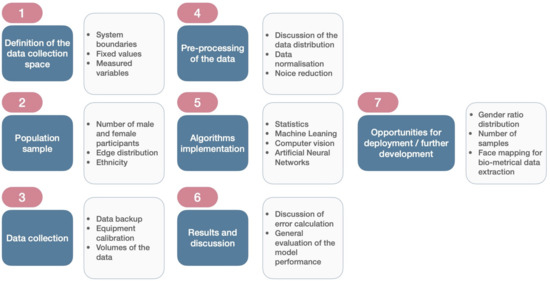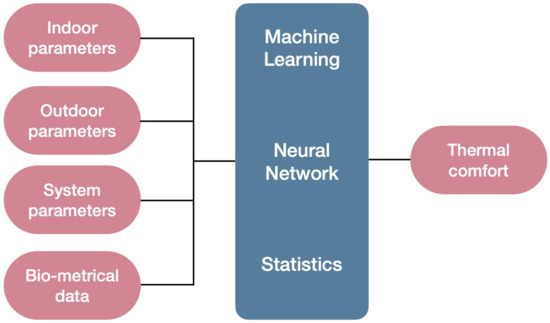Since 1997, scientists have been trying to utilize new non-invasive approaches for thermal discomfort detection, which promise to be more effective for comparing frameworks that need direct responses from users. Due to rapid technological development in the bio-metrical field, a systematic literature review to investigate the possibility of thermal discomfort detection at the work place by non-invasive means using bio-sensing technology was performed. Firstly, the problem intervention comparison outcome context (PICOC) framework was introduced in the study to identify the main points for meta-analysis and, in turn, to provide relevant keywords for the literature search. In total, 2776 studies were found and processed using the preferred reporting items for systematic reviews and meta-analyses (PRISMA) methodology. After filtering by defined criterion, 35 articles were obtained for detailed investigation with respect to facility types used in the experiment, amount of people for data collection and algorithms used for prediction of the thermal discomfort event. The given study concludes that there is potential for the creation of non-invasive thermal discomfort detection models via utilization of bio-sensing technologies, which will provide a better user interaction with the built environment, potentially decrease energy use and enable better productivity. There is definitely room for improvement within the field of non-invasive thermal discomfort detection, especially with respect to data collection, algorithm implementation and sample size, in order to have opportunities for the deployment of developed solutions in real life. Based on the literature review, the potential of novel technology is seen to utilize a more intelligent approach for performing non-invasive thermal discomfort prediction. The architecture of deep neural networks should be studied more due to the specifics of its hidden layers and its ability of hierarchical data extraction. This machine learning algorithm can provide a better model for thermal discomfort detection based on a data set with different types of bio-metrical variables.
- thermal comfort
- non-invasive discomfort detection
- machine learning
- indoor environment
- bio-sensing
Introduction
but a totally different response will accrue if it is summer and the outside temperature is 30ºC.
Discussion


Conclusions
This entry is adapted from the peer-reviewed paper 10.3390/app10124085
References
- Shin-Ichi Tanabe; Masaoki Haneda; Naoe Nishihara; Workplace productivity and individual thermal satisfaction. Building and Environment 2015, 91, 42-50, 10.1016/j.buildenv.2015.02.032.
- Ana Chadburn; Judy Smith; Joshua Milan; Productivity drivers of knowledge workers in the central London office environment. Journal of Corporate Real Estate 2017, 19, 66-79, 10.1108/jcre-12-2015-0047.
- Mark Mulville; Nicola Callaghan; David Isaac; The impact of the ambient environment and building configuration on occupant productivity in open-plan commercial offices. Journal of Corporate Real Estate 2016, 18, 180-193, 10.1108/jcre-11-2015-0038.
- Haynes, B.P; Impact of workplace connectivity on office productivity. Journal of Corporate Real Estate 2008, 10, 286-302, 10.1108/14630010810925145.
- Takashi Akimoto; Shin-Ichi Tanabe; Takashi Yanai; Masato Sasaki; Thermal comfort and productivity - Evaluation of workplace environment in a task conditioned office. Building and Environment 2010, 45, 45-50, 10.1016/j.buildenv.2009.06.022.
- Baričič, Andrej, Temeljotov Salaj, Alenka.; The impact of office workspace on the satisfaction of employees and their overall health-research presentation. Zdravniški vestnik 2014, 83, 217-231, .
- Alenka Temeljotov-Salaj; The synergetic effect of the observer on the built environment. Urbani izziv 2009, 16, 163-167, 10.5379/urbani-izziv-en-2005-16-02-005.
- António Figueiredo; Romeu Vicente; José Alberto Marques Lapa; Claudino Cardoso; M. Fernanda Rodrigues; Jérôme Kämpf; Indoor thermal comfort assessment using different constructive solutions incorporating PCM. Applied Energy 2017, 208, 1208-1221, 10.1016/j.apenergy.2017.09.032.
- Liu Yang; Haiyan Yan; Joseph C. Lam; Thermal comfort and building energy consumption implications – A review. Applied Energy 2014, 115, 164-173, 10.1016/j.apenergy.2013.10.062.
- Yacine Allab; Margot Pellegrino; Xiaofeng Guo; Elyes Nefzaoui; Andrea Kindinis; Energy and comfort assessment in educational building: Case study in a French university campus. Energy and Buildings 2017, 143, 202-219, 10.1016/j.enbuild.2016.11.028.
- António Figueiredo; José Figueira; Romeu Vicente; Rui Maio; Thermal comfort and energy performance: Sensitivity analysis to apply the Passive House concept to the Portuguese climate. Building and Environment 2016, 103, 276-288, 10.1016/j.buildenv.2016.03.031.
- Francesca Romana D'ambrosio Alfano; Bjarne W. Olesen; Boris Igor Palella; Giuseppe Riccio; Thermal comfort: Design and assessment for energy saving. Energy and Buildings 2014, 81, 326-336, 10.1016/j.enbuild.2014.06.033.
- Jowkar, Mina, Hom Bahadur Rijal, Azadeh Montazami, James Brusey, and Alenka Temeljotov-Salaj.; The influence of acclimatization, age and gender-related differences on thermal perception in university buildings: Case studies in Scotland and England. Building and Environment 2020, 179, 106933, .
- Marchenko, A.; Carlucci, S.; Pagliano, L.; Pietrobon, M.; Karlessi, T.; Santamouris, M.; Delaere, N.;Assimakopoulos, M. The assessment of the environmental quality directly perceived and experienced by the employees of 69 European offices. In Proceedings of the 10th Windsor Conference: Rethinking Comfort, Windsor, UK, 12–15 April 2018; pp. 1017–1028.
- Michael A. Humphreys; J. Fergus Nicol; Iftikhar A. Raja; Field Studies of Indoor Thermal Comfort and the Progress of the Adaptive Approach. Advances in Building Energy Research 2007, 1, 55-88, 10.1080/17512549.2007.9687269.
- Cristiana Verona Croitoru; Ilinca Nastase; Florin Bode; Amina Meslem; Angel Dogeanu; Thermal comfort models for indoor spaces and vehicles—Current capabilities and future perspectives. Renewable and Sustainable Energy Reviews 2015, 44, 304-318, 10.1016/j.rser.2014.10.105.
- Attia, S.; Hensen, J.L. Investigating the impact of different thermal comfort models for zero energy buildings in hot climates. In Proceedings of the 1st International Conferenceon Energy and Indoor Environment for Hot Climates, Doha, Qatar, 24–26 February 2014.
- Fanger, P.O. Thermal Comfort. Analysis and Applications in Environmental Engineering; Danish Technical Press: Copenhagen, Denmark, 1970.
- Standard, A. Standard 55-2010, Thermal Environmental Conditions for Human Occupancy; American Society of Heating, Refrigerating, and Air-Conditioning Engineers: Atlanta, GA, USA, 2010.
- ISO. ISO 7730:2005 Ergonomics of the Thermal Environment—Analytical determination and Interpretation of Thermal Comfort Using Calculation of the PMV and PPD Indices and Local Thermal Comfort Criteria; ISO: Geneva, Switzerland, 2005; p. 10.
- Y.H. Yau; Bt Chew; A review on predicted mean vote and adaptive thermal comfort models. Building Services Engineering Research and Technology 2012, 35, 23-35, 10.1177/0143624412465200.
- Runming Yao; BaiZhan Li; Jing Liu; A theoretical adaptive model of thermal comfort – Adaptive Predicted Mean Vote (aPMV). Building and Environment 2009, 44, 2089-2096, 10.1016/j.buildenv.2009.02.014.
- Nicol, J.F.; Humphreys, M. Understanding the adaptive approach to thermal comfort. ASHRAE Trans. 1998, 104, 991–1004.
- Nicol, F.; Humphreys, M.; Roaf, S. Adaptive The rmal Comfort: Principles and Practice; Routledge: Abingdon, UK, 2012.
- Yuanda Cheng; Jianlei Niu; Naiping Gao; Thermal comfort models: A review and numerical investigation. Building and Environment 2012, 47, 13-22, 10.1016/j.buildenv.2011.05.011.
- Weiwei Liu; Zhiwei Lian; Bo Zhao; A neural network evaluation model for individual thermal comfort. Energy and Buildings 2007, 39, 1115-1122, 10.1016/j.enbuild.2006.12.005.
- Ueda, M.; Taniguchi, Y.; Aoki, H. A new method to predict the thermal sensation of an occupant using a neural network and its application to the automobile HVAC system. JSME Int. J. Ser. B Fluids Therm. Eng. 1997, 40, 166–174.
- Xiaogang Cheng; Bin Yang; Thomas Olofsson; Guoqing Liu; Haibo Li; A pilot study of online non-invasive measuring technology based on video magnification to determine skin temperature. Building and Environment 2017, 121, 1-10, 10.1016/j.buildenv.2017.05.021.
- B. Pavlin; G. Carabin; G. Pernigotto; A. Gasparella; Renato Vidoni; An Embedded Mechatronic Device for Real-Time Monitoring and Prediction of Occupants’ Thermal Comfort. Volume 8: Heat Transfer and Thermal Engineering 2018, , , 10.1115/imece2018-87632.
- Laftchiev, E.; Nikovski, D. An IoT system to estimate personal thermal comfort. In Proceedings of the 2016 IEEE 3rd World Forum on Internet of Things (WF-IoT), Reston, VA, USA, 12–14 December 2016; pp. 672–677.
- Tanaya Chaudhuri; Deqing Zhai; Yeng Chai Soh; Hua Li; Lihua Xie; Xianhua Ou; Convolutional Neural Network and Kernel Methods for Occupant Thermal State Detection using Wearable Technology. 2018 International Joint Conference on Neural Networks (IJCNN) 2018, , , 10.1109/ijcnn.2018.8489069.
- Farrokh Jazizadeh; Geoffrey Kavulya; Laura Klein; Burcin Becerik-Gerber; Continuous Sensing of Occupant Perception of Indoor Ambient Factors. Computing in Civil Engineering (2011) 2011, , , 10.1061/41182(416)20.
- Quan Jin; Lin Duanmu; Experimental study of thermal sensation and physiological response during step changes in non-uniform indoor environment. Science and Technology for the Built Environment 2016, 22, 237-247, 10.1080/23744731.2016.1124714.
- Joon-Ho Choi; Dongwoo Yeom; Study of data-driven thermal sensation prediction model as a function of local body skin temperatures in a built environment. Building and Environment 2017, 121, 130-147, 10.1016/j.buildenv.2017.05.004.
- Chaudhuri, T.; Zhai, D.; Soh, Y.C.; Li, H.; Xie, L. Random forest based thermal comfort prediction from gender-specificphysiologicalparametersusingwearablesensingtechnology. EnergyBuild.2018,166,391–406.
- Xiaogang Cheng; Bin Yang; Kaige Tan; Erik Isaksson; LiRen Li; Anders Hedman; Thomas Olofsson; Haibo Li; A Contactless Measuring Method of Skin Temperature based on the Skin Sensitivity Index and Deep Learning. Applied Sciences 2019, 9, 1375, 10.3390/app9071375.
- Berardo Matalucci; Kenton Phillips; Alicia A Walf; Anna Dyson; Joshua Draper; An experimental design framework for the personalization of indoor microclimates through feedback loops between responsive thermal systems and occupant biometrics. International Journal of Architectural Computing 2017, 15, 54-69, 10.1177/1478077117691601.
- Vesely, M.; Zeiler, W. Fingertip temperature as a control signal for personalized heating. In Proceedings of the 13th International Conference on Indoor Air Quality and Climate (Indoor Air 2014), Hong Kong, China, 7–12 June 2014; pp. 464–470.
- Matsuei Ueda; Yousuke Taniguchi; Hiroshi Aoki; A New Method to Predict the Thermal Sensation of an Occupant Using a Neural Network and Its Application to the Automobile HVAC System.. JSME International Journal Series B 1997, 40, 166-174, 10.1299/jsmeb.40.166.
- Mitchell, T.M. Machine Learning; McGraw Hill: New York, NY, USA, 1997.
- Bennett, K.P.; Campbell, C. Support vector machines: Hype or hallelujah? ACM SIGKDD Explor. Newsl.2000, 2, 1–13.
- Geurts, P.; Ernst, D.; Wehenkel, L. Extremely randomized trees. Mach. Learn. 2006, 63, 3–42.
- Alpaydin, E. Introduction to Machine Learning; MIT Press: Cambridge, MA, USA, 2020.
- Richter, M.M.; Weber, R.O. Case-Based Reasoning; Springer: Berlin, Germany, 2016.
- Goodfellow, I.; Bengio, Y.; Courville, A. Deep Learning; MIT Press: Cambridge, MA, USA, 2016.
- Jongseong Gwak; Motoki Shino; Kazutaka Ueda; Minoru Kamata; Effects of Changes in the Thermal Factor on Arousal Level and Thermal Comfort. 2015 IEEE International Conference on Systems, Man, and Cybernetics 2015, , , 10.1109/smc.2015.169.
- Da Li; Carol C. Menassa; Vineet R. Kamat; Non-intrusive interpretation of human thermal comfort through analysis of facial infrared thermography. Energy and Buildings 2018, 176, 246-261, 10.1016/j.enbuild.2018.07.025.
- Siliang Lu; Weilong Wang; Shihan Wang; Erica Cochran Hameen; Thermal Comfort-Based Personalized Models with Non-Intrusive Sensing Technique in Office Buildings. Applied Sciences 2019, 9, 1768, 10.3390/app9091768.
- Katarina Katić; Rongling Li; Jacob Verhaart; Wim Zeiler; Neural network based predictive control of personalized heating systems. Energy and Buildings 2018, 174, 199-213, 10.1016/j.enbuild.2018.06.033.
- Ivana Špelić; Alka Mihelić-Bogdanić; Anica Hursa Šajatović; Standard Methods for Thermal Comfort Assessment of Clothing. Standard Methods for Thermal Comfort Assessment of Clothing 2019, , , 10.1201/9780429422997.
- Deqing Zhai; Tanaya Chaudhuri; Yeng Chai Soh; Energy efficiency improvement with k-means approach to thermal comfort for ACMV systems of smart buildings. 2017 Asian Conference on Energy, Power and Transportation Electrification (ACEPT) 2017, , , 10.1109/acept.2017.8168568.
- Andrei Claudiu Cosma; Rahul Simha; Machine learning method for real-time non-invasive prediction of individual thermal preference in transient conditions. Building and Environment 2019, 148, 372-383, 10.1016/j.buildenv.2018.11.017.
- Ali Ghahramani; Guillermo Castro; Burcin Becerik-Gerber; Xinran Yu; Infrared thermography of human face for monitoring thermoregulation performance and estimating personal thermal comfort. Building and Environment 2016, 109, 1-11, 10.1016/j.buildenv.2016.09.005.
- Lu, S.; Cochran Hameen, E. Integrated IR Vision Sensor for Online Clothing Insulation Measurement. In Proceedings of the 23rd International Conference of the Association for Computer-Aided Architectural Design Research in Asia (CAADRIA), Beijing, China, 17–19 May 2018; Volume 1, pp. 565–573.
- Francesco Salamone; Lorenzo Belussi; Cristian Currò; Ludovico Danza; Matteo Ghellere; Giulia Guazzi; Bruno Lenzi; Valentino Megale; Italo Meroni; Integrated Method for Personal Thermal Comfort Assessment and Optimization through Users’ Feedback, IoT and Machine Learning: A Case Study †. Sensors 2018, 18, 1602, 10.3390/s18051602.
- Wei Li; Jili Zhang; Tianyi Zhao; Indoor thermal environment optimal control for thermal comfort and energy saving based on online monitoring of thermal sensation. Energy and Buildings 2019, 197, 57-67, 10.1016/j.enbuild.2019.05.050.
- Liliana Barrios; Wilhelm Kleiminger; The Comfstat - automatically sensing thermal comfort for smart thermostats. 2017 IEEE International Conference on Pervasive Computing and Communications (PerCom) 2017, , , 10.1109/percom.2017.7917872.
